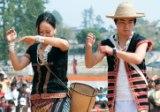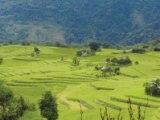A WINDOW TO IDU - MISHMIS WAY OF LIFE
Keh-Meh-Ha
Chow Bilaseng Namchoom
 “The Land of dawn-lit mountains”, Arunachal Pradesh is situated at the north-east extremity of the country. Geographically, the picturesque hill state lies between 260 28' to 290 30' N latitudes and 910 30' to 970 30' E longitudes and is spread over an area of 83,743 sq. km. It is bounded by Bhutan to the west (160 km), China to the north and north-east (1,080 km), and Myanmar to the east (440 km). It shares inter-state boundary with Nagaland in the east and south-east and Assam in the south.
“The Land of dawn-lit mountains”, Arunachal Pradesh is situated at the north-east extremity of the country. Geographically, the picturesque hill state lies between 260 28' to 290 30' N latitudes and 910 30' to 970 30' E longitudes and is spread over an area of 83,743 sq. km. It is bounded by Bhutan to the west (160 km), China to the north and north-east (1,080 km), and Myanmar to the east (440 km). It shares inter-state boundary with Nagaland in the east and south-east and Assam in the south.
| The most exciting seasonal agricultural festivals of the Idu Mishmis is known as “Keh-meh-ha” |
The knowledge about history of Arunachal Pradesh and its people is based mainly on oral literature and a number of historical ruins found in foothills areas. Legend has it that the sage Parashuram atoned for his sin, sage Vyasa meditated, King Bhismaka founded his kingdom and Lord Krishna married his consort Rukmini in this region. As such, many believe that the earliest citations about the origin of Arunachal Pradesh are found in the epics of Mahabharata, Ramayana and other Vedic legends. The widely scattered archaeological remains- Malinithan, Bhishmaknagar, Rukmininagar, Itafort, Bhalukpung, Nakshaparvat, Parsi-Parlo, etc. found at different places in Arunachal Pradesh bear testimony to its rich cultural heritage and linkages with the rest of the country. During the medieval period, a number of Buddhist monuments of Mahayana tradition were constructed at Tawang, Dirang, Kalaktang and Mechukha. The Tawang Monastery of 1681 A.D. is the largest and most celebrated Buddhist monastery of the State.
 The pristine and awe-inspiring Arunachal Pradesh is a home to many tribes and sub tribes. Idu Mishmi who is popularly known as the Kera-ah, is one of the major tribes of this land of rising sun. Idus (Kera-ahs) who inhabit in the hills and mountainous ranges in eastern most part of the state as well as the foothills of Lower Dibang Valley, Dibang Valley and Lohit district, are permanent aborigines. Idu Mishmis also reside in Aohali and Singa villages, under Tuting and Mebo circle of Siang region and in some pockets of Upper Siang and East Siang districts.
The pristine and awe-inspiring Arunachal Pradesh is a home to many tribes and sub tribes. Idu Mishmi who is popularly known as the Kera-ah, is one of the major tribes of this land of rising sun. Idus (Kera-ahs) who inhabit in the hills and mountainous ranges in eastern most part of the state as well as the foothills of Lower Dibang Valley, Dibang Valley and Lohit district, are permanent aborigines. Idu Mishmis also reside in Aohali and Singa villages, under Tuting and Mebo circle of Siang region and in some pockets of Upper Siang and East Siang districts.
The Idu Mishmis can be distinctively identified among other tribes of the state by their typical hairstyle, distinctive costumes with artistic patterns embedded. People of sober nature, they still maintain deep-rooted aesthetic values in their day-to-day life with great pride and honor. The Idus have their distinct dialect, which falls under the Tibeto-Burman group of languages. The major festivals of the Idus are ‘Reh’ and ‘Ke-meh-ha’. Reh festival is held during the month of February. It is an occasion for people to relax, enjoy, dance, eat and drink.
 The Idu-Mishmi community of the state celebrates Keh-Meh-Ha festival annually on September 24. It is a post harvest festival and is celebrated every year on the advent of winter season. ‘Keh-Meh-Ha’ in Idu dialect means eating new rice. On this day, offering is given to gods for good yield of harvest. The day-long colourful celebration is embroidered with traditional folk dances, rituals and community feast. The preparation for Keh-Meh-Ha begins with the family preparing for the occasion. The females of house begin preparing rice beer (Yu) in two separate vessels. The process of preparing the rice beer is known as the YUH-TOMBO-KOH. It means brewing rice beer for tree stump, as it is believed that the spirit of Apeh Milli of Apesha, dwells in trees. The female preparing the offering has to follow different taboos strictly. The rice beer prepared in the second vessel is meant for human consumption.
The Idu-Mishmi community of the state celebrates Keh-Meh-Ha festival annually on September 24. It is a post harvest festival and is celebrated every year on the advent of winter season. ‘Keh-Meh-Ha’ in Idu dialect means eating new rice. On this day, offering is given to gods for good yield of harvest. The day-long colourful celebration is embroidered with traditional folk dances, rituals and community feast. The preparation for Keh-Meh-Ha begins with the family preparing for the occasion. The females of house begin preparing rice beer (Yu) in two separate vessels. The process of preparing the rice beer is known as the YUH-TOMBO-KOH. It means brewing rice beer for tree stump, as it is believed that the spirit of Apeh Milli of Apesha, dwells in trees. The female preparing the offering has to follow different taboos strictly. The rice beer prepared in the second vessel is meant for human consumption.
The festival, marked by elaborate rituals and dances, form an essential element of the socio-cultural life of the tribal community. The festival showcases freshness, thrill and excitement of life in an every moment of it, the penchant of the community towards its natural surroundings. The festival is intricately linked to the community’s love for nature. Particularly, the Idu Mishmi (Kera-ahs) is one of the explicit exhibitions of the presence of rich and colorful festivals of the state and the best traditional handloom dresses are worn by both males and females in a unique show of ethnic grandeur. It is a symbolic gesture at the times of festivals like Keh-meh-ha, and Reh festival.
The most exciting seasonal agricultural festivals of the Idu Mishmis is known as “Keh-meh-ha”, which derives from the first seasonal harvest of crops like paddy and various seasonal crops which are harvested from the middle part of September in an every year. These festivals bring us lure, unity and gaiety, brotherhood among the Kera-ahs as well as religious fervor and communal harmony and a unique oneness. It is a festival of joy with traditional pomp and gaiety without any differences among the rich and poor, colour and sex. Everyone celebrates the festival throughout the day and night on the auspicious day of Keh-meh-ha.
| The knowledge about history of Arunachal Pradesh and its people is based mainly on oral literature and a number of historical ruins found in foothills areas. |
The philosophy of this festival, which orients from the beginning of the jhum cultivation of the local villagers are known as APPU and AMRO. APPU- means the first seasonal crop of rice ,which is being harvested by the villagers, and AMRO is a crop of rice harvesting in the winter part of December in the same year. As it has a mythology, philosophical rituals and rites are involved. The festival basically aims at keeping the tribal community a close-knit one in a common platform so as to preserve the true nature of Keh-meh-ha.
The philosophy and mythology pertaining to the festival is that the Keh-meh-ha is observed and celebrated in every year to worship the deity goddess of “APEH-MILLI” and “APEH-GONLO”. According to the Idu people’s mythology, ‘INYI-MENGA-AH’, the ancestor of Kera-ah, accept food grains. Hence, ADIZIRU, the Igu (priest) of Reh sends the bird to (APESHA), where the varieties of crops are grown in abundance.
 The APESHA is believed to be an enchanting place, which shines golden as the paddy waves beneath the gentle breeze. It is also believed that the APEH MILLI is the goddess of the crops and the APEH-GONLO, guards the crops from the disasters. Therefore, it is believed that it is only possible for the tiny birds like IPIH and PEKA to bring the grains. Further it is believed that the bird IPIH has brought paddy grains and the birds PEKA has brought corn etc. from the APESHA (sufficient food grains), which is cultivated and harvest by “INYI-MENGA- AH (Kera-ahs), along with food grains, providing EHUTO (hand wood grinding),ELOBE (hole of wood for grinding grains) was prepared and EH-PEH (straw wheeler of grains or winnow made from bamboo) was crafted, so as to peel and husk from the grains for human consumption.
The APESHA is believed to be an enchanting place, which shines golden as the paddy waves beneath the gentle breeze. It is also believed that the APEH MILLI is the goddess of the crops and the APEH-GONLO, guards the crops from the disasters. Therefore, it is believed that it is only possible for the tiny birds like IPIH and PEKA to bring the grains. Further it is believed that the bird IPIH has brought paddy grains and the birds PEKA has brought corn etc. from the APESHA (sufficient food grains), which is cultivated and harvest by “INYI-MENGA- AH (Kera-ahs), along with food grains, providing EHUTO (hand wood grinding),ELOBE (hole of wood for grinding grains) was prepared and EH-PEH (straw wheeler of grains or winnow made from bamboo) was crafted, so as to peel and husk from the grains for human consumption.
 As mythology goes, the spider (Ephinga) brought the medicine KANDI- ROH and INYI-ROH , which was mixed with powdered rice and became a PAH (yeast of fermentation for mixing in the rice beer), was finally prepared. PAH is put through a series of churning in order to extricate the poisonous components. At first the ‘AMRON’ (Makek Monkey) was fed and later it became an experience of screams, as it had consumed the poisonous contents of PAH. Later, the frog was also fed, due to which it lost its teeth ! Which indicated that all the poison had been extricated and was finally fit for human consumption. Finally the rice and PAH were mixed, which became an origin of YUH (rice beer). It was offered to APEH MILLIH of APESHA (the goddess of plenty of crops) and other omnipotent, omniscient spirits believed to be dwelling in the paddy (Keh-mrah) rice fields, house and granary (Akka). It is also celebrated with festivity and beliefs that if some guest come at the time of celebration it would bring good fate and showering of prosperity, good yield and further also increase the life span of the host of the village. Since the ancient times, the occasion has been celebrated by generation after generation and has come to be known as KEH-MEH-HA, which is today celebrated in a broader spectrum and ideology of whole Kera-ahs. The state government has even declared September 24 every year as local holiday for areas inhabited by Idu Mishmis to facilitate celebration of the festival of Keh-meh-ha.
As mythology goes, the spider (Ephinga) brought the medicine KANDI- ROH and INYI-ROH , which was mixed with powdered rice and became a PAH (yeast of fermentation for mixing in the rice beer), was finally prepared. PAH is put through a series of churning in order to extricate the poisonous components. At first the ‘AMRON’ (Makek Monkey) was fed and later it became an experience of screams, as it had consumed the poisonous contents of PAH. Later, the frog was also fed, due to which it lost its teeth ! Which indicated that all the poison had been extricated and was finally fit for human consumption. Finally the rice and PAH were mixed, which became an origin of YUH (rice beer). It was offered to APEH MILLIH of APESHA (the goddess of plenty of crops) and other omnipotent, omniscient spirits believed to be dwelling in the paddy (Keh-mrah) rice fields, house and granary (Akka). It is also celebrated with festivity and beliefs that if some guest come at the time of celebration it would bring good fate and showering of prosperity, good yield and further also increase the life span of the host of the village. Since the ancient times, the occasion has been celebrated by generation after generation and has come to be known as KEH-MEH-HA, which is today celebrated in a broader spectrum and ideology of whole Kera-ahs. The state government has even declared September 24 every year as local holiday for areas inhabited by Idu Mishmis to facilitate celebration of the festival of Keh-meh-ha.
Today, celebration of Keh-meh-ha has seen a major transition with the way the present generation has been influenced by modern life styles It is natural that any ethnic festival cannot remain intact in isolation and the fusion is the way of life in the modern globalized society. The way of changing pattern, process, and arrangement of festivals are going on side by side without causing harm or discarding the age-old system. Therefore, the change is a law of nature, as society can’t remain in static. At the same time, it should not be encouraged to do away with the stamp of rich culture and traditions that are jewels of the age old system and practices.

